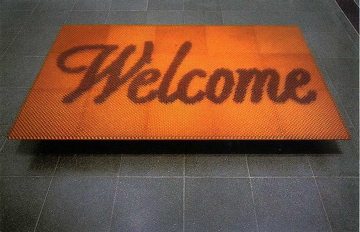
Do-Ho Suh, "Doormat: Welcome (Amber)," 1998
Last week I promised to begin addressing some of the questions that came up at the recent National Art Education Association conference in Minneapolis. One of our first questions comes from Vicky Grube, an Assistant Professor at Appalachian State University in North Carolina, who asked, “How does Art21 help teachers, especially student teachers, get beyond traditional teaching styles they’ve experienced growing up?”
Art21 provides a variety of ways for teachers to “go beyond” and take healthy risks in their teaching. At the Art21.org website, teachers can sign in and download free teaching materials, including the Learning with Art21 Guide and any of the Art21 Educator Guides for each of the first four seasons. In these guides, teachers are encouraged to use the Before and After-Viewing questions to inspire students to think critically about what they see and what they can create.
Teachers can also explore the links and huge variety of posts right here on the Art21 blog in order to share columns and guest articles with their students. For example, students can read a collection of blog posts around a single theme and develop a written or visual response to one particular piece. Teachers are encouraged to browse and share over 50 posts written for this Teaching with Contemporary Art column. They can also view a series of videos in order to analyze and compare how artists get the same message across in wildly different ways.
But perhaps I should take a step back and also consider what exactly are these “traditional” teaching styles Vicky is referring to? First of all, when I think of traditional art teachers I certainly don’t come up with exclusively negative images. I have had plenty of traditional art teachers that were absolutely phenomenal. What I think Vicky is asking about, are the teachers who rely on units and lessons, strategies and activities, that are comfortable but not always meaningful for students. Perhaps some of these teaching strategies include the drilling and killing of teaching the elements and principles of design? Perhaps other strategies include projects that mimic an artist’s style instead of learning about the artist and about the work in order to produce original ideas?
Teaching materials on Art21.org and resources right here on the blog can help teachers, especially student teachers, plan for specific ways to open up conversations in their classrooms, think about big ideas with their students, and create work that gets beyond mimicry or what’s simply become habitual.
How do you use Art21 to “go beyond” in your own teaching?




Pingback: Authoritarian? | Art21 Blog